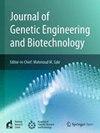Screening and genomic evaluation of keratinolytic protease producing Chryseobacterium sp. from tannery waste and its potential application in dehairing of goat skin
IF 2.8
Q3 Biochemistry, Genetics and Molecular Biology
Journal of Genetic Engineering and Biotechnology
Pub Date : 2025-01-19
DOI:10.1016/j.jgeb.2025.100458
引用次数: 0
Abstract
Lime and Na2S, used in dehairing in the tannery industry, cause the generation of toxic wastes. Ecological security and financial issues demand a look for innovative approaches to leather dehairing free from pollution. The primary goal of this investigation was to explore keratinolytic protease producing bacteria from tannery waste, their genomic evaluation and to assess their possible use in the dehairing process. A newly isolated Gram-negative bacterium (LRI-TA6) was characterized and checked for its keratinolytic protease producing ability. The strain was identified as Chryseobacterium cucumeris through whole genome sequencing. The genome was 4,541,898 bp in size and contain 4,426 protein coding sequences (CDS) with 36.38 % of GC content. Twenty-five open reading frames (CDS) were found as protease producing genes notably DegQ (serine protease), DegS, and ATP-dependent protease DP (EC 3.4.21.-). The isolate revealed enzyme production throughout an extended pH range of 5.0 to 8.0, and a broad temperature range of 10 °C to 38 °C. The isolate LRI-TA6 was sensitive to all five antibiotics (amoxicillin, tetracycline, gentamicin, ciprofloxacin, and vancomycin) with zone diameter ranges from 17.2 ± 0.8 to 32 ± 0.0 mm. The enzyme was shown to have 29.9 ± 6.7 and 83.6 ± 0.2 U/ml of keratinolytic and proteolytic activity, respectively. By employing crude keratinase, the removal of hair from goat skin was accomplished in 18 h. This study is the first report to isolate and characterize C. cucumeris from tannery waste and also the amazing 18 h dehairing capabilities and thus might be utilized for further studies towards commercial synthesis of keratinase for use in leather processing sectors.

制革废料中产角朊蛋白酶的黄杆菌的筛选、基因组评价及其在山羊脱毛中的潜在应用
制革业中用于脱毛的石灰和Na2S会产生有毒废物。生态安全和财务问题要求寻找无污染的皮革脱毛创新方法。本研究的主要目的是探索从制革废物中产生角朊酶的细菌,对其基因组进行评估,并评估其在脱毛过程中的可能用途。对一株新分离的革兰氏阴性菌(LRI-TA6)进行了鉴定,并对其产生角朊酶的能力进行了检测。该菌株经全基因组测序鉴定为黄瓜黄杆菌。基因组大小为4541898 bp,包含4426个蛋白质编码序列(CDS), GC含量为36.38%。25个开放阅读框(CDS)被发现是蛋白酶产生基因,特别是DegQ(丝氨酸蛋白酶),DegS和atp依赖性蛋白酶DP (EC 3.4.21.-)。该分离物在5.0至8.0的扩展pH范围和10°C至38°C的宽温度范围内显示酶生产。菌株LRI-TA6对阿莫西林、四环素、庆大霉素、环丙沙星、万古霉素5种抗生素均敏感,带直径范围为17.2±0.8 ~ 32±0.0 mm。结果表明,该酶具有29.9±6.7和83.6±0.2 U/ml的角蛋白水解活性和蛋白水解活性。利用粗角化酶,在18小时内完成了山羊皮毛的脱毛。这是第一个从制革废料中分离和表征黄瓜黄瓜的研究,也证明了其惊人的18小时脱毛能力,因此可以进一步研究用于皮革加工部门的角化酶的商业化合成。
本文章由计算机程序翻译,如有差异,请以英文原文为准。
求助全文
约1分钟内获得全文
求助全文
来源期刊

Journal of Genetic Engineering and Biotechnology
Biochemistry, Genetics and Molecular Biology-Biotechnology
CiteScore
5.70
自引率
5.70%
发文量
159
审稿时长
16 weeks
期刊介绍:
Journal of genetic engineering and biotechnology is devoted to rapid publication of full-length research papers that leads to significant contribution in advancing knowledge in genetic engineering and biotechnology and provide novel perspectives in this research area. JGEB includes all major themes related to genetic engineering and recombinant DNA. The area of interest of JGEB includes but not restricted to: •Plant genetics •Animal genetics •Bacterial enzymes •Agricultural Biotechnology, •Biochemistry, •Biophysics, •Bioinformatics, •Environmental Biotechnology, •Industrial Biotechnology, •Microbial biotechnology, •Medical Biotechnology, •Bioenergy, Biosafety, •Biosecurity, •Bioethics, •GMOS, •Genomic, •Proteomic JGEB accepts
 求助内容:
求助内容: 应助结果提醒方式:
应助结果提醒方式:


